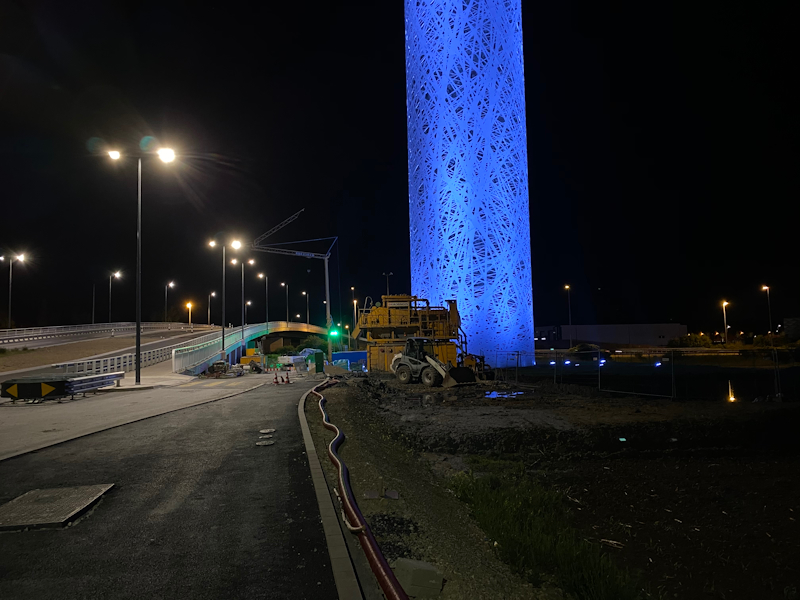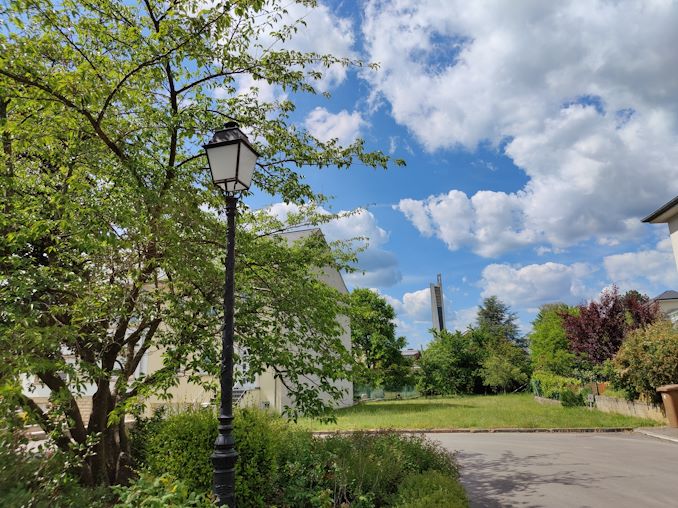The OnePlus 8, OnePlus 8 Pro Review: Becoming The Flagship
by Andrei Frumusanu on June 29, 2020 10:00 AM ESTCamera Recap - Amongst The Best
Last week, we published a more extensive dedicated camera article comparing a larger swath of recent flagship devices that have been released in last few months, including the new OnePlus 8 and OnePlus 8 Pro. I would suggest reading that piece for a more extensive camera analysis of not only the OnePlus 8’s, but also put in better context against its closest competitors:
Read Our Extensive Camera Evaluation For More Samples:
Mobile Flagship Phone Camera Overview 2020 H1: Still Picture Battle
I’ll quickly go over the key characteristics of the two phones in a few samples here:

[ OnePlus 8 ] - [ OnePlus 8 Pro ]
[ iPhone 11 Pro ] - [ iPhone SE ] - [ Pixel 4 ]
[ Galaxy S20U(S) ] - [ Galaxy S20+(E) ]
[ V60 ] - [ Mi 10 Pro ]
[ Mate 30 Pro ] - [ P40 Pro ]
[ Reno3 Pro 5G ] - [ Reno3 Pro ]
[ X-T30 ]
Between the 8 Pro and the regular 8, it’s generally evident that the 8 Pro has the better picture quality thanks to better detail retention and more dynamic range. The phone’s processing is generally amongst the best and competes with Samsung and Apple in terms of handling of tones, although the OnePlus phones more often seem to miss having the better exposure handling, such as in the above scene where both phones are flattening the highlights too much.
In terms of the phones’ main camera 48MP capture modes, it’s the 8 Pro that is the clear winner as the bigger pixels of the superior sensor are able to capture and retain more fine details.
A negative for the phone’s camera processing is that OnePlus continues to apply an artificial darkening filter on the shadows, whilst this increases the contrast of the scenes, it creates unnatural images with elements that nearly clip to black, something that had been introduced last year on the OnePlus 7 Pro as an attempt to copy the Pixel 3’s look – which Google ironically had fixed this aspect on the Pixel 4.

[ OnePlus 8 ]
[ OnePlus 8 Pro ]
[ iPhone 11 Pro ] - [ iPhone SE ] - [ P4 ]
[ Galaxy S20U(S) ]
[ Galaxy S20+(E) ]
[ V60 ]
[ Mi 10 Pro ]
[ Mate 30 Pro ]
[ P40 Pro ]
[ Reno3 Pro 5G ]
[ Reno3 Pro ]
[ X-T30 ]
In terms of telephoto photography, the OnePlus 8 Pro notably is the better phone as it features a dedicated camera module for this task, whilst the OnePlus 8 has to make due with digital cropping, although it’s not as bad thanks to the switch to the camera’s switch to their native 48MP modes.
In the ultra-wide photos, the OnePlus 8 Pro is again the clear winner thanks to its hardware advantages, achieving better details and dynamic range. Both phones are able to showcase good results, although colours aren’t as realistic as on Apple’s and Samsung’s ultra-wides.

[ OnePlus 8 ]
[ OnePlus 8 Pro ]
[ iPhone 11 Pro ] - [ iPhone SE ] - [ Pixel 4 ]
[ Galaxy S20U(S) ]
[ Galaxy S20+(E) ]
[ V60 ]
[ Mi 10 Pro ]
[ Mate 30 Pro ]
[ P40 Pro ]
[ Reno3 Pro 5G ]
[ Reno3 Pro ] - [ X-T30 ]
In low-light photography, OnePlus has been able to make major leaps forward in terms of quality thanks to improved software processing. It’s especially the OnePlus 8 Pro which has the quality lead as the phone’s superior camera sensor showcases a clear advantage to that of the OnePlus 8. In fact, the OnePlus 8 Pro consistently fared as amongst the best performers in low-light photography now, sometimes ending up as the top performer thanks to its excellent new Nightscape implementation.
The 8 Pro’s comparatively large ultra-wide module sensor also means that it’s amongst the best performers in low-light, only being beaten by the even larger sensors of Huawei devices.
One aspect we didn’t cover in our camera comparison article was the OnePlus 8 Pro’s “colour filter camera”. First of all, OnePlus did an absolutely abysmal job in actually describing the technical aspects of this camera and what it actually does. Although switching to this camera module is amongst the colour filter options in the camera UI, its effects are anything but a filter.
Any camera sensor and module on any device out there is able to capture infra-red light by default – it’s just that usually to limit the wavelengths that it sees to that of a human eye, vendors employ an IR blocking filter layer between the camera sensor and the optics. In the OnePlus 8 Pro, this layer is missing, and thus this extra camera module is able to actually capture infrared wavelengths. In fact, hobbyists out there even actively modify their digital cameras to remove this filter to achieve IR photography.
The fact that OnePlus hasn’t been able to explain the technical details of this module in their marketing materials is extremely unfortunate as there’s been a ton of misunderstanding as to what it actually does – even going so far that there’s been a backlash with privacy concerns as the camera can see through some materials that are transparent to IR light but opaque to visible light, with OnePlus even saying they’ll be removing the feature in a software update. I no longer have the phone so I don’t know if it’s actually been disabled or not, but I do find it a pity if it’s gone as it was able to achieve some very unique pictures, especially of vegetation in sunlight.
Read Our Extensive Camera Evaluation For More Samples:
Mobile Flagship Phone Camera Overview 2020 H1: Still Picture Battle
Overall, the OnePlus 8 Pro and OnePlus 8 are both good camera shooters. The regular OnePlus 8 doesn’t convince as much as its hardware disadvantages are clearly limiting what it can achieve. In this regard, the pictures it’s able to produce are adequate but it has trouble compete with the quality of the competition.
The OnePlus 8 Pro is a much better choice if you value the camera experience. OnePlus has made big leaps in the processing and picture quality. In daylight it competes with Apple and Samsung – although I still do think the phone’s shadow handling is too artificial an unrealistic – but that’s a subjective opinion. In low-light, thanks to the new processing and upgraded sensor hardware both on the main sensor and the ultra-wide camera, the OnePlus 8 Pro consistently is amongst the best performers in low-light. Overall, the 8 Pro delivers an excellent camera capture experience that’s plenty versatile.














92 Comments
View All Comments
boeush - Monday, June 29, 2020 - link
Yup. People with expensive high-fidelity headphones want to be able to listen to their extensive, high-fidelity music catalogs on their expensive, high-fidelity flagship smartphone. I don't see what's so hard for designers/vendors to comprehend about this...Just because Apple decided to go full retard with deliberate omission of a headphone jack, doesn't mean the rest of the world has to voluntarily lobotomize itself in response. Even though it did, and continues to do so - it doesn't HAVE TO keep on doing it. Idiots....
wr3zzz - Monday, June 29, 2020 - link
OnePlus8 pretty much makes the case that flagship killer is henceforth pointless. There is hardly any "need" that can only be possible on $1000+ phones for 99% of the usage cases. Since OnePlus7 Pro, the extra $300-500 tacked onto the flagship class phones are mostly for checklist and not utility. Rational consumer, i.e, the flagship killer demo, pay for need and not marketing.Quantumz0d - Monday, June 29, 2020 - link
Not a flagship at all when it lacks 3.5mm jack and no Micro SD slot. Esp with their proprietary bullshit charging and uber high speed, high current, high voltage battery destroying tech all for Samsung level of price with their bloated garbage Oxygen OS.And it's CCP powered. Only good thing about this phone is its Bootloader unlockability.
watzupken - Monday, June 29, 2020 - link
"Not a flagship at all when it lacks 3.5mm jack and no Micro SD slot. Esp with their proprietary bullshit charging and uber high speed, high current, high voltage battery destroying tech all for Samsung level of price with their bloated garbage Oxygen OS."My question to you is whether you have used a OnePlus phone before to come to the conclusion that the Oxygen OS is garbage? I have not tested the OneOS from Samsung, but the Oxygen OS is leaps and bounds cleaner and smoother than the old TouchWiz OS from Samsung. Having used a OnePlus 7 Pro for some time, I feel the software support/updates from OnePlus is also better than Samsung. I am confident to say that Samsung probably included more bloatware than OnePlus, since OxygenOS is pretty much the closest to the stock Android experience.
The lack of micro SD slot is a bummer, but 3.5mm jack is pretty much missing in most of the new flagship phones.
Siva - Monday, June 29, 2020 - link
Coming from a pixel 3 to the OnePlus 8 this phone is incredible but the camera is straight trash.serendip - Monday, June 29, 2020 - link
What's Samsung's secret sauce for the high CPU numbers on the SD865?Roph - Tuesday, June 30, 2020 - link
Too bad both the headphone jack and MicroSD slot are missing, making it totally irrelevant to me. "Never settle", right?Also bizarre that the reviewer says good riddance to a pop-up camera. Having a piece of the screen missing is a negative.
Absolutely don't want these phones, I wouldn't use them even if they were free.
airdrifting - Tuesday, June 30, 2020 - link
It's funny OnePlus's mainstream model beats their high end "Pro" mode practicality wise. I almost never considered the "Pro" model.Brane2 - Tuesday, June 30, 2020 - link
After so many iterations, what does "flagship phone" even mean ?Does anyone even care anymore ?
When you need a toothpick, do you go for base model or check the sites for a "flagship" one ?
AsturzioAugias - Tuesday, June 30, 2020 - link
Thanks for the detailed review, from a new op8pro user.In your opinion, in terms of battery drain what the difference will be between 90hz and 120hz?